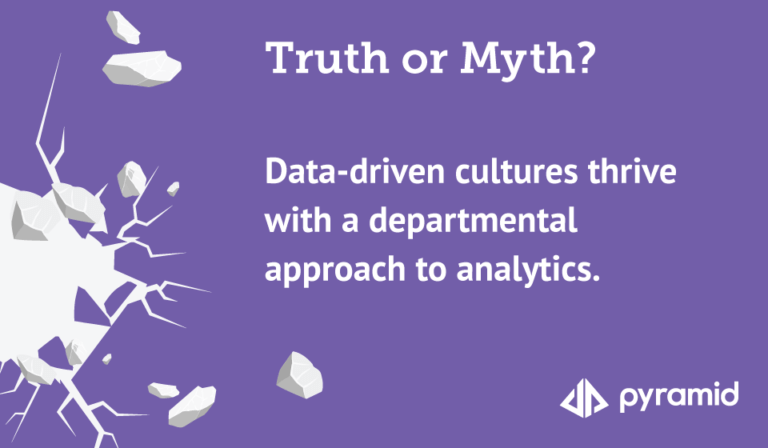As business leaders scale their analytics investments, they rarely recognise the ROI of analytics is intimately tied to company culture. Companies can struggle to make progress with analytics because they fail to understand the importance of cultural change to the success of their investments.
If your analytics strategy doesn’t align with the needs of your employees, users will chart their own course. Separate data silos, applications and even individual cultures will emerge within the organization, hindering business progress and impeding their individual success.
As a result, business leaders must identify and address the cultural obstacles they need to overcome. It’s critical that those who manage analytics and those who use them to drive real business value see eye-to-eye. But countless companies still aren’t sure how to begin this transformation—and don’t even think of it as a transformation.
Here we explore the key ways organizations can align their analytics strategy and company culture. I’ll examine how people, technology, accessibility and data availability can obstruct or contribute to analytics success.
Eight Cultural Changes That Improve Analytics Success
As Gartner describes, “Changing the culture of the organization means changing the hearts and minds of individual employees.” Indeed, for any organization that depends on data, the universal goal must be to become data-driven, united by those who manage the data and those who use it.
But while both technical and business users may share this goal, the means by which they try to achieve it can differ drastically. Failure to see the others’ core interests lies at the very heart of conflict in failed analytics examples and they derail even the best-intentioned analytics and BI initiatives.
1. Improve the delivery of your data
Analytics is as much about technology investment as it is about change management within the organization. Your ability to provide users with automated features, self-service capabilities and a shared view of insights depends on increasing user access to high-quality company data.
Employees who own and manage data have a responsibility to other like-minded employees. That means treating data like the assets they are—tied to performance and revenue, as well as customer and employee satisfaction—and embracing a culture of companywide access to insights that drive results in these areas.
2. Creating opportunities for collaboration
Just as data becomes more available, employees at all levels of the organization need access to tools and channels that improve collaborative use of that data to drive results. Rather than relying on workarounds, business users need dedicated mechanisms within approved platforms to work with one another, share insights and work towards mutual objectives. As we already observed, employees are more likely to continue to use your new tools if they are realizing value from those tools in their individual capacities.
3. Eliminate data silos and data fiefdoms
Data silos remain an ongoing problem at most companies, and new technology investments alone won’t solve them. Instead, business leaders must help employees across teams and departments change their habits, leveraging centralized tools and resources while ensuring new best practices take hold. Business leaders can start by prioritizing individual business units, eliminating those “data fiefdoms” in them as they work towards a more unified view of company data.
4. Create more opportunities for data-driven decisions
“Organizations arrive in different ways at the ability to put data and actionable insights into the hands of decision makers,” as McKinsey describes. Although the needs of the day are unpredictable, employees need reliable access to insights that will help them, whatever those challenges might be.
With the right analytics tools, non-technical business users can fulfill their own data requests without direct support from technical users, such as data scientists. These capabilities allow those users to take charge of problems directly and truly “own” their solutions. Creating this culture of self-realized success and providing data access that boosts those results is a powerful way to align analytics and culture.
5. Increase institutional awareness among business leaders
Business leaders are historically far from analytics processes, even as they make critical decisions that affect their entire companies. Too often, these leaders lack awareness of how well analytics solutions are taking hold and flourishing among their employees as well.
“In companies with strong data cultures, important decisions are informed by data and analytics and executives act on analytically derived insights rather than intuition or experience,” Harvard Business Review describes. Analytics must become accessible to these senior executives and to all types of employees.
Fortunately, their adoption of these technologies not only drives better decisions, but it also instills confidence in employees as they begin using analytics themselves. Leaders’ success with analytics demonstrates to employees that they too can improve their decision-making with these new capabilities.
6. Increase situational awareness among non-technical teams
Just as business leaders can become more successful through data-driven insights, teams at all levels of the organization can improve performance and business results with greater situational awareness. Individual access to analytics provides non-technical users with the insights they need to understand the true impact of their decisions on business results.
“As a data-driven culture is more a factor of influence than of control, spread the word about how data and analytics can help drive business results across business units,” Gartner recommends. Indeed, teams who access analytics themselves as they take on challenges in real time are more likely to realize the value of their contributions—and rightfully take ownership of the results.
7. Adopt a more flexible analytics architecture
The analytics technology you choose should also reflect the cultural goals of your company. This prevents individual teams and departments from using unapproved tools, which forces data leaders to take a reactive stance to what otherwise might be innovative solutions.
Employees and teams will have their own unique reasons for accessing insights from analytics, so the technology that supports them should reflect this diversity. That may mean reconfiguring organizational processes and even replacing technologies, rather than forcing employees to adopt practices they are unlikely to keep up.
8. Free your teams to make successful decisions
Each employee’s work-life comprises an ongoing series of decisions—big ones and small ones of all different varieties. And yet only 13% of employees at high-performing companies say their companies are very effective at encouraging employees to use data for making daily decisions, according to a McKinsey study.
When business leaders align their employees with a universal analytics tool—a single source of insights they can all understand and use—they ensure employees have everything they need to make successful decisions for themselves, their teams, and their company. It’s the responsibility of business leaders, in that case, to cultivate a culture that truly values analytics.
Bring Out the True Value of Your Analytics Investment
Data leaders who acknowledge the cultural component to analytics success are most likely to align their people, processes, and technology for business success. Choosing the right analytics platform, in that case, depends on their understanding of their employees, their habits and what they need to succeed.
Pyramid Analytics is purpose-built for companies ready to embrace a culture that values and uses analytics for ongoing business success. Contact us to learn more about how a centralized solution can help you and your employees take on the challenges of the day, every day.
Originally published on the Global CIO Institute blog.












